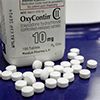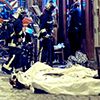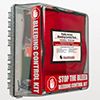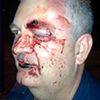As the year comes to an end, we look at the stories that stood out and generated vigorous discussion and passionate debate. Some events particularly marked the year, and made EMS providers reconsider their role and their profession. Read our take on the top events of 2015 and share your thoughts and additions in the comments.
1. Opioid overdose epidemic worsens
 Drug overdoses became the leading cause of injury-related deaths in the U.S., surpassing vehicle crashes. Prescription opioid overdoses being the most common. The use of naloxone has become essential for EMS providers, police and bystanders. As more and more public safety agencies stocked naloxone, the drug’s costs skyrocketed across the U.S. at the beginning of the year. To get the most common overdose antidote in as many hands as possible, CVS started selling over-the-counter Narcan in 12 new states; a Kentucky group taught children and teens how to use naloxone; and experts issued recommendations on naloxone availability and use. The new American Heart Association CPR guidelines suggested the use of naloxone for patients with a pulse, but not breathing normally. Finally, in November the FDA approved Narcan nasal spray, the first FDA-approved nasal spray version of naloxone hydrochloride.
Drug overdoses became the leading cause of injury-related deaths in the U.S., surpassing vehicle crashes. Prescription opioid overdoses being the most common. The use of naloxone has become essential for EMS providers, police and bystanders. As more and more public safety agencies stocked naloxone, the drug’s costs skyrocketed across the U.S. at the beginning of the year. To get the most common overdose antidote in as many hands as possible, CVS started selling over-the-counter Narcan in 12 new states; a Kentucky group taught children and teens how to use naloxone; and experts issued recommendations on naloxone availability and use. The new American Heart Association CPR guidelines suggested the use of naloxone for patients with a pulse, but not breathing normally. Finally, in November the FDA approved Narcan nasal spray, the first FDA-approved nasal spray version of naloxone hydrochloride.
 The American Heart Association released the “2015 Guidelines Update for CPR and ECC” in October, addressing compression rates and depth, AED and social media use, temperature and “pit-crew” CPR for medics. We covered the updates in depth, analyzing how the new guidelines would affect EMS providers, educators and managers. Test your knowledge of the 2015 updates by taking our test!
The American Heart Association released the “2015 Guidelines Update for CPR and ECC” in October, addressing compression rates and depth, AED and social media use, temperature and “pit-crew” CPR for medics. We covered the updates in depth, analyzing how the new guidelines would affect EMS providers, educators and managers. Test your knowledge of the 2015 updates by taking our test!
3. New terrorist threat emerges
 In November a series of coordinated terrorist attacks shook Paris, marking not only the deadliest violence to strike France since World War II, but also a new type of terror attacks: Hybrid Targeted Violence (HTV). Medics and other health care providers handled 302 patients and described their response as “civil application of war medicine.” Experts weighed in on what HTV attacks mean and how first responders can prepare for them.
In November a series of coordinated terrorist attacks shook Paris, marking not only the deadliest violence to strike France since World War II, but also a new type of terror attacks: Hybrid Targeted Violence (HTV). Medics and other health care providers handled 302 patients and described their response as “civil application of war medicine.” Experts weighed in on what HTV attacks mean and how first responders can prepare for them.
4. Public access hemorrhage control
 This year, public access control devices entered the national dialogue, with schools adopting active shooter casualty kits and fire departments installing severe bleeding kits in public spaces. The Obama administration launched the “Stop the Bleed” campaign in October, with the goal of putting the knowledge gained by EMS and military personnel in the hands of the public to stop life-threatening bleeding and raise awareness about public access to bleeding control kits. Off-duty bailout bags started becoming more popular among first responders.
This year, public access control devices entered the national dialogue, with schools adopting active shooter casualty kits and fire departments installing severe bleeding kits in public spaces. The Obama administration launched the “Stop the Bleed” campaign in October, with the goal of putting the knowledge gained by EMS and military personnel in the hands of the public to stop life-threatening bleeding and raise awareness about public access to bleeding control kits. Off-duty bailout bags started becoming more popular among first responders.
 The stabbings of two Detroit medics in October and two San Diego firefighters in June raised public awareness about EMS providers’ safety while on scene. Photos of the bloodied and bruised face of an Australian medic, viciously attacked in his own ambulance, distributed around the globe further reinforced the dangers EMS providers face every day. EMS organizations and fire departments across the country decided to undergo new training and started considering body armor implementation. In light of the many attacks on medics, the states of New York and Minnesota decided to implement or introduce new legislation, making it a felony to assault EMS providers.
The stabbings of two Detroit medics in October and two San Diego firefighters in June raised public awareness about EMS providers’ safety while on scene. Photos of the bloodied and bruised face of an Australian medic, viciously attacked in his own ambulance, distributed around the globe further reinforced the dangers EMS providers face every day. EMS organizations and fire departments across the country decided to undergo new training and started considering body armor implementation. In light of the many attacks on medics, the states of New York and Minnesota decided to implement or introduce new legislation, making it a felony to assault EMS providers.












